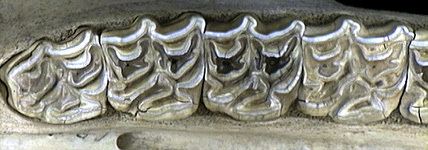The Basic Structure of Cheek Teeth

The cheek teeth (molars and premolars) of mammals are often marvelously complex and adapted to specific tasks. Their morphology has provided a rich source of material for studying both mammalian phylogeny and the process and pattern of evolution. Complex structure inevitably leads morphologists to creating complex terminology, and the sheer number of terms that a student of dental variation may encounter is overwhelming. For example, Philip Hershkovitz, in a monograph of a group of South American rodents (1962, Fieldiana: Zoology, 46:1-524), created a very useful and much-followed terminology that included over 60 names to describe variation in the surfaces of a set of six teeth (three upper, three lower) none of which is much larger than the head of a pin!
In this section, we focus on the pattern of cusps and other structures located mainly on the occlusal surface of molars. Fortunately, we have a reasonably good idea of how these patterns have evolved, and they can be traced back to a fairly simple pattern present in the earliest mammals. By learning this primitive design, a few rules mostly concerning suffixes and prefixes, and a few common patterns of modification, most of us can get by well enough to navigate the literature of dental taxonomy and evolution. A more complete summary of terminology and patterns appropriate for the mammalogy student can be found in DeBlase and Martin's excellent Manual of Mammalogy (1981, Wm. C. Brown Company Publishers), including references to the technical literature on the subject.
As for as the basic rules of naming tooth structures, each cusp is called a cone. Different cones are identified by different prefixes, the major ones being proto-, para-, meta-, hypo-, and ento-. Minor cusps may have the suffix -ule added to the name (e.g., hypoconule). An -id added to the name of a cusp indicates that it is part of a tooth in the lower jaw; for example, a protocone is a major cusp on an upper molar, while a protoconid is on a lower molar. A cingulum is a shelf-like ridge around the outside of an upper molar, cingulid on a lower tooth. The stylar shelf is an an expansion of the cingulum; it often bears small cusps (each with its own name...).
The earliest mammals had relatively simple cheek teeth made up of three cusps lying nearly in a line or low triangle. These cusps were surrounded by a cingulum on both labial and lingual sides. The highest cusp of the upper tooth occluded with the space between adjacent lower teeth, resulting in shearing (in a manner like that of pinking shears).
The earliest therian mammals (placentals and marsupials) had similar upper teeth, with three cusps arranged in a triangle, with the base running along the labial edge of the tooth. In the upper jaw, the cusp at the apex of the triangle (on the lingual side) is termed the ; the anterior cusp along the labial margin is the ; and the posterior cusp along the same margin is the (these and other features of the surface of teeth are shown in an accompanying photographs of bunodont, zalambdodont, and dilambdodont teeth). These teeth had a substantial stylar shelf (labial to the paracone and metacone), which contained several smaller cusps (styles). This set of three major cusps is the . Lower teeth also contain a trigon (called ), but the triangle of cusps is turned around, with the labial and the and on the lingual side (see photograph). In addition, a low shelf, called the or , develops at the posterior end of the tooth. It is ringed by three cusps, the labial , lingual , and between them, the (see photograph). When upper and lower teeth meet in chewing, the protocone of the upper tooth occludes with the talonid basin of the lower tooth. This arrangement of trigon(id) and talonid basin is called . It is still found unmodified or only slightly modified in some mammals, for example, opossums. From it, we can derive the structure of most other mammalian teeth.
Finally, a few more terms: a (cristid) is a crest or ridge. The term is usually given a prefix that describes location (e.g., entocrista). A (lophid) is a ridge that is formed by the elongation (and sometimes fusion) of cusps. This term also is usually modified by a prefix (e.g., mesoloph). is a term that is sometimes used to refer to an upper tribosphenic molar; refers to a lower tribosphenic molar.
Contributors
Phil Myers (author).